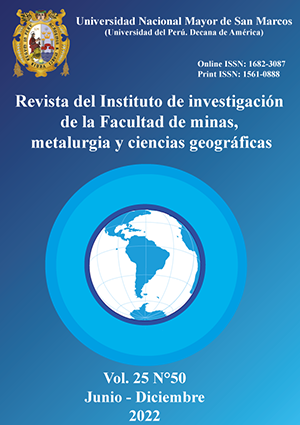Effect of charge loading during electrocoagulation in dairy wastewater
DOI:
https://doi.org/10.15381/iigeo.v25i50.24247Keywords:
charge loading, dairy industry, electrocoagulation, turbidity removal, wastewaterAbstract
Electrocoagulation is frequently studied considering only the current or current density as a determining parameter when looking for the optimal conditions of wastewater treatment; however, these are correlated to the charge loading parameter that regulates the dose of metal to be dissolved. Due to this, the present study incorporates the charge loading to find the optimal conditions of treatment by electrocoagulation to the effluents of a dairy industry, “La Planta Piloto de Leche” of Universidad Nacional Agraria La Molina, taking as a variable response to the removal of turbidity. Work has been done in batch on prototypes of 2.2 liters of effective capacity. The aluminum and iron electrodes, acting as anode and cathode respectively, were the best materials for the treatment, in addition, the highest turbidity removal was achieved at a pH of 8 and a charge flow of 5.65 F/m3, achieved at 2 Ampere (2A) of supplied current and 10 minutes of treatment. Subsequently, the test under a constant load flow (5.65 F/m3) reaffirmed that at 2A and 10 minutes of electrochemical treatment, the highest removals of contaminants, mainly oils and greases, and turbidity are achieved.
Downloads
Published
Issue
Section
License
Copyright (c) 2022 Jaime Alberto Cachay Melly, Lawrence Enrique Quipuzco Ushñahua

This work is licensed under a Creative Commons Attribution 4.0 International License.
AUTHORS RETAIN THEIR RIGHTS:
a. Authors retain their trade mark rights and patent, and also on any process or procedure described in the article.
b. Authors retain their right to share, copy, distribute, perform and publicly communicate their article (eg, to place their article in an institutional repository or publish it in a book), with an acknowledgment of its initial publication in the Rev. Inst. investig. Fac. minas metal cienc. geogr.
c. Authors retain theirs right to make a subsequent publication of their work, to use the article or any part thereof (eg a compilation of his papers, lecture notes, thesis, or a book), always indicating the source of publication (the originator of the work, journal, volume, number and date).






